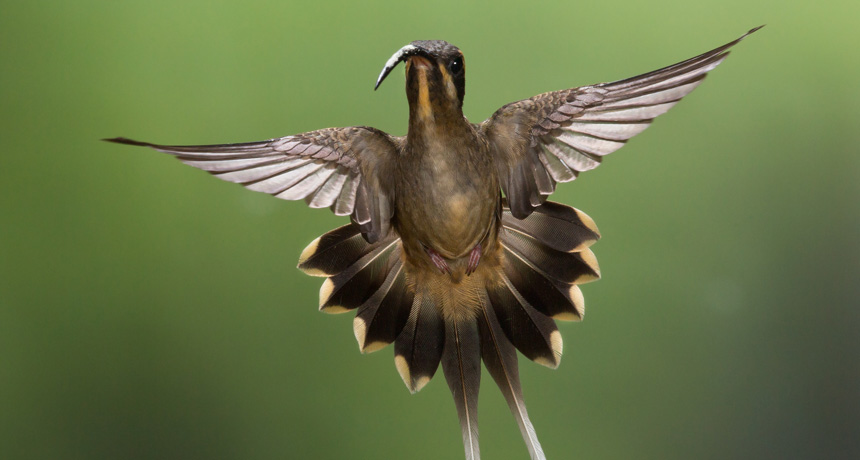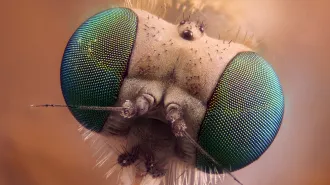Hummingbirds take stab at rivals with dagger-tipped bills
Males reaching the age of competitive courtship grow a sharp weapon

WEAPONS Hummingbird bills can turn into dagger-pointed weapons among long-billed hermits (shown in flight).
Chris Jimenez
Male hummingbirds that mate in the feathered version of singles bars grow sharp points on their bills, perfect for jabbing rivals.
That little dagger point forms on the upper part of the bill as young male long-billed hermits (Phaethornis longirostris) reach adulthood, reports Alejandro Rico-Guevara of the University of Connecticut in Storrs. And tests of those hummingbirds’ bills show that enhanced tips boost piercing power. Birds don’t grow horns or antlers. But a dagger-tipped bill may have evolved as male-versus-male weaponry, Rico-Guevara and Marcelo Araya-Salas of New Mexico State University in Las Cruces suggest October 18 in Behavioral Ecology.
“I know this is going to be controversial,” Rico-Guevara says. In recent years research in other hummingbird species has emphasized flower-feeding as an evolutionary force that explains why the shapes of male and female bills differ. If the sexes favor different flower species, bill shapes could diverge as they accommodate different floral throats.

To test for a role of weaponized bills, he visited patches of forest in Costa Rica where male long-billed hermits gather within meters of each other and spend almost all day chirping for months. “They have some stamina,” he says.
Serenades and genes are all the males provide for a female in this species, so a few superb birds can monopolize a large proportion of female visitors. Despite months of effort, ho-hum hummingbirds can end up in a reproductive dead end. “When you’re in the middle of them, you can feel the tension,” Rico-Guevara says.
Bill-jabbing fights certainly did break out. Rico-Guevara describes one intruder hovering over a male perched on a twig and darting in repeatedly to deliver eyeblink-quick stabs to the percher’s throat.
Catching and measuring 159 birds confirmed that the dagger tip is the mark of an adult male. The tip is tiny, poking just about 0.4 millimeters from the upper part of the bill. Yet when the researchers tested its piercing power, males and their sharp bill tips needed less force to poke a hole in plastic food wrap than the blunter bills of females and youngsters did. The researchers also photographed each bill and mathematically analyzed the geometry to determine pointiness. Males armed with larger and pointier bills were more likely than less equipped ones to win and hold a perch for courtship display.
That’s not yet enough to convince evolutionary ecologist Ethan Temeles of Amherst College in Massachusetts that courtship rivalries drive the evolution of dagger points. Temeles has linked different flower preferences with sex differences in hummingbird bills and describes himself as “sort of the loudest and longest voice on the topic.”
What Temeles would like to see now is evidence that males with the most elongated bill tips prevail in fights because of those tips and also that winning fights earns males more matings and offspring than the losers manage. Finding more ways and more funding to test the idea, Rico-Guevara says, is something he would very much like to do.
FLOWERS AND FIGHTS Long-billed hermits use their impressive bills to reach nectar in long-throated flowers (shown first) and for male rivalries during courtship season. In the shadowy shrubbery where males gather to show off, one rival jabs another repeatedly in the throat (shown first at normal speed, then at half speed). Courtesy of A. Rico-Guevara







